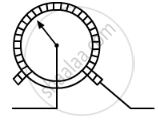Advertisements
Advertisements
प्रश्न
What happens to the resistance as the conductor is made thinner?
उत्तर
The resistance of a wire can be represented by the following equation:
`R=(rhol)/A`
So, when the conductor is made thinner, its area of cross-section will decrease, since resistance is inversely proportional to the area of the conductor. Therefore, its resistance will increase.
APPEARS IN
संबंधित प्रश्न
What is (a) the highest, (b) the lowest total resistance that can be secured by combinations of four coils of resistance 4 Ω, 8 Ω, 12 Ω, 24 Ω?
A copper wire has diameter 0.5 mm and resistivity of 1.6 × 10−8Ω m. What will be the length of this wire to make its resistance 10 Ω? How much does the resistance change if the diameter is doubled?
Why are alloys commonly used in electrical heating devices? Give reason.
Which has less electrical resistance : a thin wire or a thick wire (of the same length and same material)?
Which has more resistance:
a long piece of nichrome wire or a short one?
Give two examples of substances which are good conductors of electricity. Why do you think they are good conductors of electricity?
Calculate the resistance of a copper wire 1.0 km long and 0.50 mm diameter if the resistivity of copper is 1.7 × 10−8 Ω m.
How does the resistance of a wire change when:
its material is changed to one whose resistivity is three times?
The figure blow shows a variable resistor in a dimmer switch.

How would you turn the switch to make the lights: (a) brighter, and (b) dimmer? Explain your answer.
Write the relation between resistance and electrical resistivity of the material of a conductor in the shape of a cylinder of length `'l'` and area of cross-section `'A'` . Hence derive the S.I. unit of electrical resistivity.
